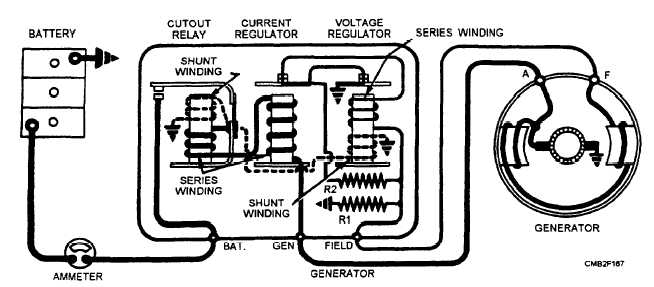Generator Maintenance
The dc generator requires periodic cleaning, lubrication, inspection of brushes and commutator, and testing of brush spring tension. In addition, the electrical connections need attention to ensure clean metal-to-metal contact and tightness.
Some generators have hinged cap oilers. Lubricate these with a few drops of medium weight oil at each maintenance cycle. Do not overlubricate, because as excessive amount of oil can get on the commutator and prevent the brushes from functioning properly.
Visually and manually inspect the condition of all cables, clamps, wiring, and terminal connections. See that the generator drive pulley is tight on the shaft and that the belt is in good condition and adjusted properly. Also, ensure that the generator is securely mounted and has a good ground.
Remove the cover band, on generator so equipped, and inspect the inner surface of the generator cover band for tiny globules of solder. If any solder is found, the generator is producing excessive current and has melted the solder used in connecting the armature wires to the commutator bars. This condition requires removal of the generator to repair or replace the armature.
If no solder is found, inspect the commutator, brushes, and electrical connections. If the commutator is dirty or slightly rough, using 00 sandpaper can smooth it. NEVER use emery cloth on the commutator.
Once the commutator has been sanded, blow compressed air through the interior of the generator to remove any excess dirt and brush particles. Lift the

Figure 2-14. - Schematic wiring diagram of a typical dc charging circuit.
brushes in the brush holder to see that they are free to operate and have sufficient tension to prevent arcing and burning of the commutator and brushes. If brushes are worn down to one half of their original length, replace them.
Most generators today are not equipped with cover bands. They may have open slots over the commutator or be sealed entirely. On those with open slots, the commutator can be sanded through the slots, but brush removal can only be accomplished by removing the commutator end frame. On sealed units, maintenance can only be performed after disassembly.
Generator Repair
Generators are disassembled only when major repairs are to be made (fig. 2-15). Other than cleaning commutators and replacing worn-out brushes during periodic maintenance, generators require very few repairs during normal service life. However, if neglected, generators will develop problems that cannot be remedied in the field.
Before removing a generator suspected of being faulty, you should check the battery, as discussed earlier, and the generator output. Refer to the manufacturer's manual for correct generator output specifications and proper testing procedures. If the generator is operating properly and the battery, wiring, and connections are in operating condition, a defective voltage regulator is indicated in which, in most cases, the regulator is removed and replaced. However, if the generator is not producing the specified amperes at the specified engine speed, then it must be removed from the vehicle and either repaired or replaced. 2-14
Continue Reading